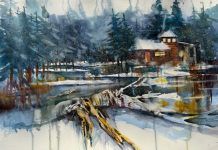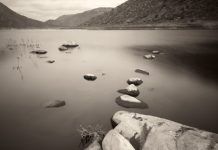The work of Blake Shaw, a local photographer, is now on exhibit at the Mission Trails Regional Park Visitor Center. Viewers will want to take their time studying the portraits of the birds Shaw has photographed in their natural environment.
As an ophthalmologist, Shaw said he has always had a vested interest in being able to see clearly. It was natural, then, to gravitate toward photography. Until about ten years ago, most of his photography was about travel or sports.
The work of Blake Shaw, a local photographer, is now on exhibit at the Mission Trails Regional Park Visitor Center. Viewers will want to take their time studying the portraits of the birds Shaw has photographed in their natural environment.
As an ophthalmologist, Shaw said he has always had a vested interest in being able to see clearly. It was natural, then, to gravitate toward photography. Until about ten years ago, most of his photography was about travel or sports.
“Then I realized that 365 days a year, there were birds to photograph in San Diego County,” Shaw said.
Between other projects, often on holidays like Christmas or New Year’s Day, Shaw would go to local parks to photograph some of the larger birds, like ducks, egrets and herons.
On New Year’s Day, 2007, Shaw went to Lindo Lake in the early morning to photograph ducks. On the way back to his car he photographed a bright red bird which he had never seen before. When he got home, he checked with a field guide and found that it was a Vermilion Flycatcher.
“Every birder will tell you that there was one bird that got them hooked on birding,” said Shaw. “The Vermilion Flycatcher was mine.”
Not long after, Shaw enrolled in bird identification classes through the Audubon Society.
“That really took my bird photography to another level, once I knew the birds I was looking at, where to find them, some of their behavior, as well as their songs and calls,” he said.
The increase in Shaw’s bird knowledge and photography have made for some awe-inspiring images which he has made into prints on canvas.
Ann Hornby, a friend of Shaw’s and also an ophthalmologist, became smitten with Shaw’s portrait of a blue-footed booby he photographed in Mexico. She bought it at the reception on August 19.
“I love the details, particularly in the bird’s feathers – you can tell from the way they are standing straight up that he was on alert,” Hornby said, adding that the splash of water behind the bird added to the drama of the photograph.
Pat McGann said she found herself drawn to a photograph of Elegant Terns in Bolsa Chica. In the photograph, some of the terns are flying wildly about while others are sitting on the ground.
“I am completely intrigued with this photo,” said McGann. “The birds in flight look like brush strokes on the canvas. I know enough about photography and about birds to know that this was hard to capture. It has such an ethereal quality.”
Some favorite local spots that Shaw visits to photograph birds are Santee Lakes, Lindo Lake, Lake Hodges, the La Jolla Cove area and the San Diego River Estuary next to Robb Field.
Shaw often photographs at Lake Murray where a few years ago he encountered a Yellow-headed Blackbird, which is rather uncommon in most of San Diego.
“In all of these locations, birds are usually abundant, and the birds there become accustomed to people, so allow closer approach then elsewhere,” Shaw said.
A true hotspot of bird photography in all seasons for Shaw is the Salton Sea. He works near that area two mornings a month, making it fortuitous for him to photograph there on the afternoons and evenings.
“I especially like incorporating the Salton Sea itself into many of the photos, so they become more than just photos of the birds,” he said. “They become more like landscape photos.”
At the Salton Sea, Burrowing Owls are plentiful and easy to locate.
“They are favorites of many viewers,” said Shaw, adding that he has two burrowing owl pictures in the exhibit.
The Salton Sea also has countless Sand Hill Cranes and Snow Geese. In the winter months, flocks of thousands upon thousands of these birds spend time near the southern edge of the lake. At sunrise and after sunset the sky will be obscured by thousands of birds as they take off in the morning and return to their roosts at night.
“The calls of thousands of geese or cranes is unmistakable and awe-inspiring. Though I have seen this spectacle dozens of times, I get goosebumps each time,” Shaw said.
Shaw keeps it simple in the field while photographing birds and nature. In the past, he nearly always had a tripod and heavy lens. Trying to use this combination in the forests of Mexico, however, was a frustrating proposition.
“My guide would locate a bird close to us,” said Shaw. “By the time I would have my camera set up and ready, the bird was already gone. My guide, who did not use a tripod, would get the shot. That was the last time I used a tripod.”
These days, Shaw uses a relatively lighter long lens which he can carry with a special strap. Modern cameras are so sensitive to light that high shutter speeds can be used when hand-holding with little detriment to the photo, so the tripod becomes less necessary for Shaw’s style.
“My enjoyment of bird photography is as much being out of doors enjoying nature, as getting good photos,” he said. “Not having to carry a heavy tripod allows me greater mobility to find birds, as well as to enjoy my time spent outdoors.”
As time passes, Shaw adds more and more bird species to his life-list, and finding a new bird becomes more challenging. In order to find new ones, he will often travel to new locations.
One such occasion—and a favorite memory for Shaw—was a year ago in the San Pedro Martir National Park in Baja California. Shaw spent two days looking for the California Condors, particularly at a viewpoint where they are frequently seen. He said he waited for quite a while.
“Suddenly, a number of them seemingly appeared out of nowhere and flew back and forth over the ridge in front of me,” he said. “They are such large birds, nearly a ten-foot wingspan, they take your breath away.”
Taking breath away is what all of Shaw’s images do for the viewer. His work will be up through September 14.
To learn more about Blake Shaw and his work, go to www.photoabcs.com














